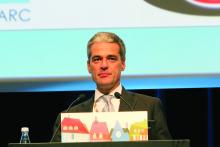COPENHAGEN – Hard data are hard to come by in sarcoma, but interim results from a randomized trial show that combination chemotherapy with an anthracycline and an alkylating agent offers both a relapse-free and overall survival benefit for patients with soft tissue sarcomas of the trunk wall or extremities, compared with histology-driven therapies.
In a study comparing three cycles of a full-dose epirubicin and ifosfamide combination with three cycles of one of five regimens tailored to specific sarcoma subtypes, there was an average absolute benefit in both relapse-free survival (RFS) and overall survival (OS) of approximately 20% with the combination regimen, reported Alessandro Gronchi, MD, chair of sarcoma surgery at the National Cancer Institute of Italy in Milan.
The findings come as a surprise, however, because the trial was originally designed to detect a benefit for the tailored, histology-driven therapies, and is therefore, technically, a failure, Dr. Gronchi said at the European Society for Medical Oncology Congress.
“In a population of soft-tissue sarcoma patients selected by a risk of relapse averaging 60%-70%, the neoadjuvant administration of a short full-dose anthracycline plus ifosfamide chemotherapy increases relapse-free survival of more than 20% and overall survival of at least 10%,” he said.
Chemotherapy in both the neoadjuvant and adjuvant setting for patients with high-risk soft-tissue sarcomas has been controversial, with a wide range of practices worldwide. Some centers administer neoadjuvant chemotherapy and/or radiation, followed by surgery and adjuvant radiation and/or chemotherapy, whereas other centers do not use chemotherapy, either out of concerns about toxicities, or because the evidence supporting the practice has been equivocal.
The best argument in favor of neoadjuvant chemotherapy in this setting until now has been that it can increase the chances of successful surgery (R0 resection), which is associated with longer progression-free survival and better control of both recurrence and distant metastasis, Dr. Gronchi said at a briefing prior to his presentation of the data in a symposium session.
The multicenter trial compared a regimen of epirubicin 120 mg/m2 plus ifosfamide 9 g/m2 (standard combination arm) with one of five different regimens based on the following sarcoma histologies, which comprise approximately 80% of all sarcomas of the trunk wall or extremities:
• Undifferentiated pleomorphic sarcoma (UPS): gemcitabine+docetaxel.
• High grade myxoid liposarcoma: trabectedin (Yondelis).
• Synovial sarcoma: high-dose prolonged-infusion ifosfamide.
• Malignant peripheral nerve sheath tumors (MPNST): etoposide plus ifosfamide.
• Leiomyosarcoma: gemcitabine+dacarbazine in leiomyosarcoma.
All patients had localized, high-risk soft tissue sarcomas defined as grade 3, size greater than 5 cm, and deep tumor site; the median tumor size was 10 cm in each arm.
Following chemotherapy, all resectable patients went on to surgery with or without radiation therapy.
A total of 287 patients, median age 50, were randomized either to the regimen tailored to their tumor type (142 patients), or to the combination (145). A total of 240 patients were evaluable for response.
At a median follow-up of 12.34 months, RFS rates were 62% for patients who received epirubicin-ifosfamide, compared with 38% for those who received tailored therapy, In univariate analysis, the hazard ratio for tailored therapy was 1.955 (P = .007).
Overall survival rates were 89% vs. 64%, respectively (P = .033).
An analysis of responses by RECIST (Response Evaluation Criteria in Solid Tumors) showed that more patients in the standard arm had partial responses (16% vs. 10%). Stable disease rates were comparable, at 81% and 82%, respectively. Fewer patients on the standard arm had disease progression, at 3% vs. 8%. There were no complete responses in either group.
A look at RFS by histology subtype showed that for four of the five tumor types, standard chemotherapy was better. For patients with myxoid round cell liposarcoma, however, trabecdetin was equivalent in efficacy to combination chemotherapy.
“Since the safety profile of trabecdetin is much better, it’s a much better-tolerated drug than combination epirubicin and ifosfamide, we are now aiming to reopen that strata and looking into possibly moving the drug into the first line,” Dr. Gronchi said in an interview.
Despite some limitations, the findings of this trial suggest a new standard of care in resectable soft tissue sarcomas, said invited discussant Axel Le Cesne, MD, of Gustave Roussy Cancer Center in Villejuif, France.He recommended that based on these results, ESMO guidelines for soft tissue and visceral sarcoma guidelines should be updated to read as follows (additions or substitution to the existing text shown in italics):
“If the decision is made to use CT as upfront treatment, it may well be used preoperatively. A benefit may be gained when 3 full-dose anthracycline ifosfamide chemotherapy cycles is used as upfront treatment, facilitating surgery. This regimen has ‘proven’ to give a positive impact on RFS/OS in selected high-risk soft-tissue sarcomas of extremity/trunk wall.”
He added that the guidelines should emphasize management of patients with discussion in multidisciplinary tumor boards in specialized or “reference” sarcoma centers or within reference networks sharing multidisciplinary expertise and treating a high number of patients.
Eurosarc funded the study. Dr. Gronchi and Dr. Le Cesne disclosed ties with several companies



